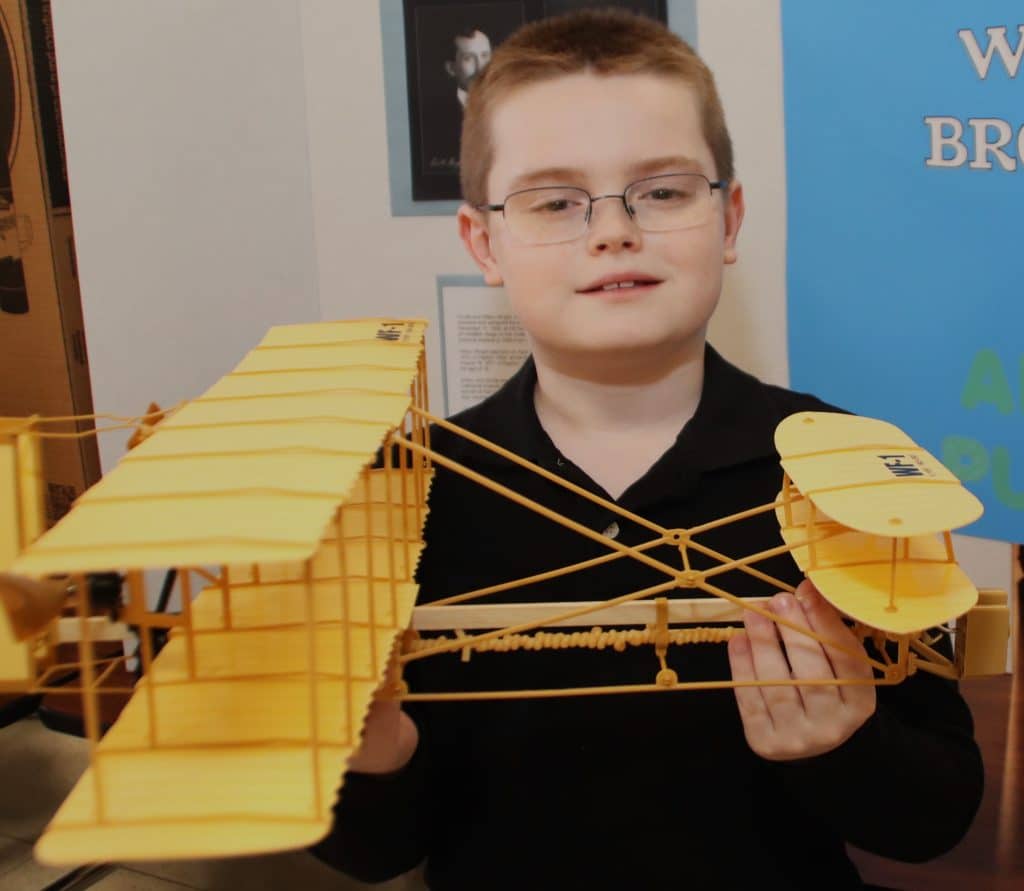Sixth grader Luci DiMauro holds a prototype of a paint box — a functional occupational therapy toy — made with recycled materials.
Reminder Publishing photo by Mike Lydick
AGAWAM — Works of more than 600 Agawam students in kindergarten through grade 6 were on display at the annual science fair hosted by Doering School on March 21.
“All of the work for the cooler communities portion of the fair was done in K-6 STEAM classes in the schools,” said Tammy Rumplik, a science teacher at Doering who helped to coordinate the event. STEAM stands for science, technology, engineering, arts and math.
The involvement of “cooler communities,” an environmental initiative, was new this year. It’s usually a separate event, but Rumplik said it made more sense to combine the events for a better experience and turnout.
The evening science fair featured more than 200 student works displayed throughout the school, including 12 posterboard projects on a variety of environmental topics. Students also made occupational therapy toys and ankle foot braces that focused on reusing materials.

Reminder Publishing photo by Mike Lydick
Rumplik said the goal of the occupational therapy toy project was to create something for a fictional child to use for a specific therapeutic need, such as pincher grasp, hand-eye coordination, wrist extension, or balance and walking.
“They used design brief work through all the steps of the process — from sketching ideas to identifying materials to use to making any improvements needed to create a functional prototype,” said Rumplik.
Sixth graders also made ankle foot orthosis and energy houses as a way to reuse and use up materials that were already at the school. Other projects included making display boards about various environmental topics, including meatless meals, renewable energy, climate change or pollution.
Sixth graders Faith Berry and Luci DiMauro were among students who created prototype occupational toys.
“I created a toy/puzzle game for a boy who likes puzzles,” said Berry. “I designed it so he could have some fun and not be bored while still working to improve his skills,” said Berry.
The puzzle started as a group project, but each student decided to make different therapy toys.
“The puzzle is made from Styrofoam squares with wooden dowels so each piece can be removed and put back by grabbing the dowel,” said the 11-year-old. “I knew he likes the color green and chicken nuggets with ketchup, so that is how I painted and decorated it.”
DiMauro’s toy was a paint set with three small toothbrushes attached to a piece of cardboard built on a box cover.
“I designed each brush to paint in different directions — up, down and side-to-side. One brush for the left side, a second for the right side and a third one in the middle so each brush can cover the entire paint board I also included,” said the 12-year-old.
It took her 30 minutes to come up with the idea and four class days to make it. Before building her prototype, DiMauro used a computer modeling program to design and test it.
“I envisioned something easy to carry and use. I covered it in yellow paint, since that was my child’s favorite color.”
Lucy Ellis was among a group of fifth graders who studied wind energy by designing and testing wind turbine blades cut from pieces of cardboard and attached to a plastic stand.
“We tested our wind turbine with one, two, three and four blades to see which blades turned the fastest. We discovered two were the fastest because they were lighter,” she said.
The 11-year-old said they also learned that although two blades were the fastest, they could get unbalanced because of their speed.
“We tested the blades in front of a fan — using one blade turned slower but was the best in our test.”
For the science fair component of the event, students choose their own topic of interest to study to allow independent thinking and learning things that interested them.
Fifth grader Andre Pudellso chose the Wright Brothers for his inventor project because their work with airplanes allowed people to travel the world more quickly and explore more places.
“They showed that through imagination, hard work and perseverance anything is possible,” he said.
His three-panel display included photos and facts about the Wright Brothers, as well as two models of the plane they successfully flew in 1903. His goal was to show more information than people might know about the two aviation pioneers.
“There’s a lot of information about them on the surface, but I wanted to get more details and information about the real story for my display,” he said.
The 10-year-old dug into his project by going to websites, but his primary research was done at the Agawam Public Library, where he pored through books about the brothers.
“Most people think Orville went first because Wilbur was too scared to do it, but the real reason is that he lost the coin toss. That was a great discovery for me,” Andre said.


